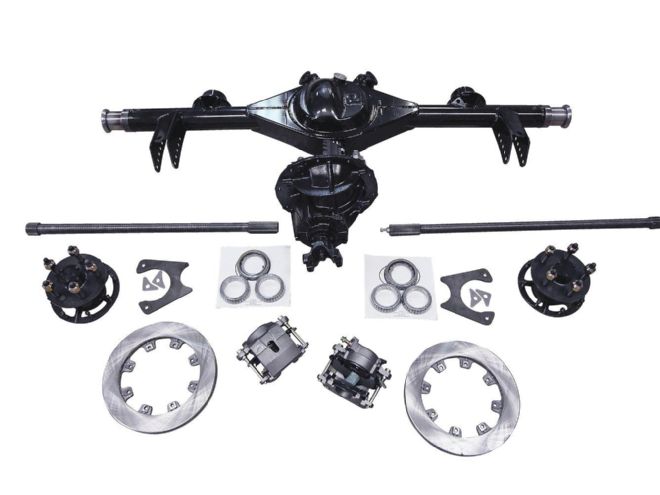
One of the biggest perks of being on the Circle Track staff is being able to regularly talk to some pretty cool people and ask them whatever you want. Imagine being able to call up your mayor and request that he replace the stop sign with a light at that annoying intersection on your way to work. Or the general manager for your favorite sports team and ask him exactly what was going through his thick skull during the draft?
It’s sort of like that, but with racing.
We recently had a very enlightening conversation with Mike Mortensen of Quick Performance. Quick Performance builds complete rearends for racing, and also supplies racers with quality racing components. One of the strengths of Quick Performance is that it understands we all aren’t racing on NASCAR Sprint Cup budgets, and offers a line of products that are both affordable for the Street Stock-level racer that’s also much higher quality than the stock components many racers try to get by with.
We hit Mortensen with several of the questions that we most often hear from racers. The information he provided us was so good we thought we’d relay it to you as-is. One of the points Mortensen stressed is that Quick Performance doesn’t mind spending time on the phone with a racer to help them improve their performance. Each racer has unique needs, and Mortensen says if that means spending a few extra minutes on the phone to make sure that they can get him or her a rearend that’s exactly the way they needed, then that is what they are willing to do.
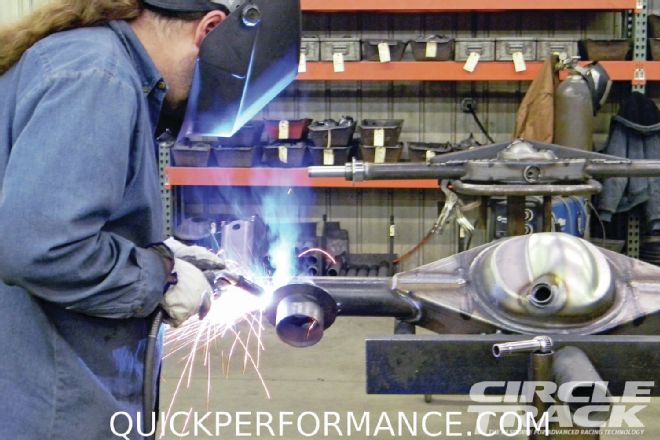 One of the trickiest parts of installing a 9-inch Ford rearend into a GM-based race car can be welding in all the brackets so that the suspension geometry remains correct. Using a manufacturer that builds rearends specific for racing means they will usually have the correct jigs to weld in the brackets, spring cups, and shock mounts necessary to allow you to bolt the rearend into your car with no hassles.
One of the trickiest parts of installing a 9-inch Ford rearend into a GM-based race car can be welding in all the brackets so that the suspension geometry remains correct. Using a manufacturer that builds rearends specific for racing means they will usually have the correct jigs to weld in the brackets, spring cups, and shock mounts necessary to allow you to bolt the rearend into your car with no hassles.
The Ford 9-inch rearend is easily the most popular in racing, but most Street Stock racers run a GM metric chassis like a Monte Carlo. What do they need to do when installing a new rear in to make sure all the suspension geometry is correct?
We can handle that for them. We build housings that are compatible with some of the GM chassis that are popular in circle track racing. So a customer can call up and tell us what he is working on, and we can jig up a suspension and build him a rearend housing that will be pretty straightforward when it comes to installing it into his race car. We typically spend enough time on the phone talking to the customers that we can get a pretty good idea what they need so we can set them up with a package that is going to be suitable for them. In most cases they can bolt the rearend into the car and be competitive right from the get-go.
Any advice finding what I need in a junkyard?
If you are trying to race with junkyard parts, it can be really hard to know what you are getting. If you are pulling a 9-inch rear out of a junkyard, that probably means it is been in service for decades by now. It could be 40, 50, maybe even 60 years old. A lot of times those rearends have been in and out of different vehicles, and they have been abused and neglected. And if you miss something it can leave you broken on the track and cost you a lot more than you saved by going to the junkyard in the first place. Plus, with older stock components, the manufacturing processes back then just weren’t as capable of maintaining quality like we have today. And often you will wind up with a setup that may not be up to the task for today’s racing conditions.
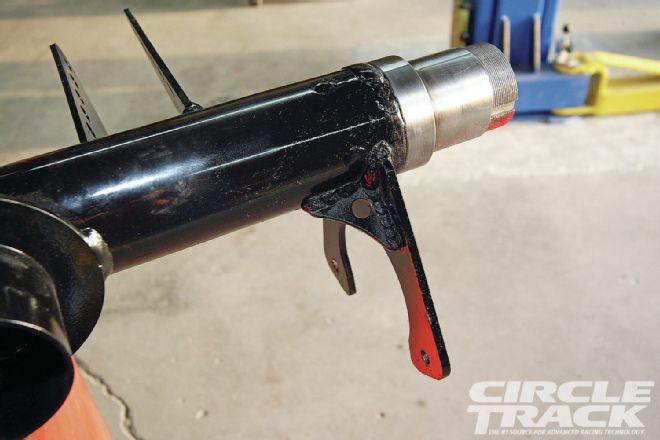 Quick Performance uses billet steel tube ends on its all-new housings which are held to much tighter tolerances than anything that you can buy from the OEM.
Quick Performance uses billet steel tube ends on its all-new housings which are held to much tighter tolerances than anything that you can buy from the OEM.
We build our own housings at Quick Performance. We do a whole new housing, or we can build a housing with a reconditioned centerpiece. That way you know everything is either brand-new or has been thoroughly inspected and brought back up to spec. We will build a rearend with all new DOM tubing, new laser cut brackets and billet steel housing ends. Now, not only do you know that everything is straight and fits in the race car like it should, but you also have the advantage of higher quality and newer technology that should help you race better with fewer failures. We can build a housing today with today’s technology that is so much better than anything Ford ever made all those years ago, and the cost really isn’t that much of a difference.
When can I get by with a cast center section and when should I upgrade to a nodular iron piece?
If you are running an entry-level class with lower horsepower levels you often can get by with a cast third member without any problems. A good example is the IMCA Hobby Stock division. We have had a lot of success helping those guys out running a reconditioned stock 9-inch third member case that we reassemble with new Temkin USA bearings, new Motive Performance gears, and either a spool or locker depending on how the car is being used. Then for guys that are a step up and beyond the entry-level divisions, we do have a new aftermarket nodular iron center section as well as even aluminum cases that we can use.
Often the rules will restrict what type of rearend you can use. If the rules say you have to run a stock rearend, that often limits you to the cast center section. But if you can choose, a general rule of thumb that I go by is if you have four hundred horsepower or more, then you are usually better off using an aftermarket nodular iron third member that can hold up to much higher levels of power and abuse.
Is spending the extra money on a lightweight ring-and-pinion set worth it?
If money is tight, we do have gearsets that are quite inexpensive. For the guys on a budget we do have a value line of gears that starts at $112, and they go on up from there. We have sets that are factory lightweight and they are typically about 2 pounds lighter than a standard set of gears. Then you can go on to REM polishing. Some guys use those in the lower levels, but if money is tight, quite often I will tell guys that they might be better off spending their money somewhere else.
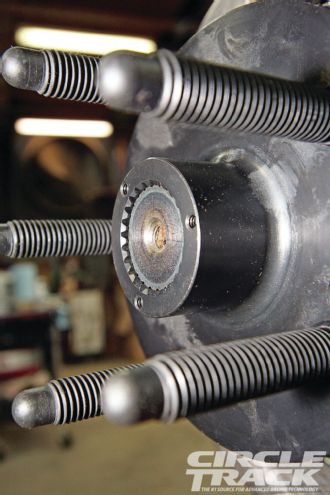 A full-floater uses axles splined on both ends. The outer end mates to a hub, which the wheel bolts to. This makes the full floater safer than other rearends as well as easier to work on.
A full-floater uses axles splined on both ends. The outer end mates to a hub, which the wheel bolts to. This makes the full floater safer than other rearends as well as easier to work on.
However, a lot of guys really do like the lightweight gearsets. They say they can tell the difference in the efficiency of their drivetrain. Cutting out the 2 pounds of rotating mass does free things up quite a bit, and drivers often say that the car will get up to speed more quickly and is more responsive to the throttle.
What is a full floating 9-inch rear?
There are basically two main styles of 9-inch rearends. From the factory Ford made a semi-floating 9-inch rearend, which is the traditional style. That uses an axle shaft that is splined on one end and a flange with wheels studs on the other end. For that particular set up we do have a heavy-duty tapered wheel bearing that is highly recommended for circle track racing. It will withstand sideloading a lot better than a standard bearing. Sometimes your rules won’t allow a full-floating rearend, so you will have to go with this traditional style, but we even have guys on a tight budget that have raced these rearends with success. The main thing is to upgrade to the better bearing and it will allow the rearend to hold up a lot longer.
A full-floater style rearend really is not too much more expensive. It uses an axle shaft that is splined on both ends, and there is a splined hub that mates with the axle and the wheel bolts to that. The axle isn’t bolted to anything, so it just kind of floats between the third member and the hub. A lot of times it comes down to the rules. Some of the more entry-level classes will not allow you to run the full floater. But if you are allowed to run either, the full floater really is a no-brainer. It is safer, it is easy to work on, and for circle track applications it really is the better setup.
What axle should I run?
The 28- and 31-spline axles are going to be the two most common choices. Both are spline counts that Ford made from the factory. I always try to recommend the 31-spline axles whenever possible because they are stronger. Sometimes a guy may already have six or seven third member setups that are already 28-spline, so you can understand why he would want to switch over to the 31-spline axles. But if you don’t have anything to begin with, you are definitely better off going with the 31-spline axles to gain that extra strength. They do hold up better to racing than the smaller 28-spline axle.
I heard you can get a gearset with a bigger pinion, which is stronger. Should I do that?
We do sell both the standard and large pinions. The big pinion gearsets are made from 9310 material, and they are called Pro Gears. But they are designed for drag racing, so they are actually made of a softer material designed to handle really high horsepower, combined with the shock of launching off the trans brake. For circle track applications, usually the 8620 standard gearsets are ideal.
What is the difference between a mini spool and a full spool? Is the mini spool smaller and lighter?
A lot of people asked me about mini spools versus full spools. The mini spool is designed to be a budget, entry-level unit. Basically, what you do is take out the standard open carrier, pull the internal pieces like the spider gears out, and replace them with the mini spool. Then you put the carrier back into the rearend. Those units are very cheap, but compared to a lightweight spool they are not as durable and they are also quite a bit heavier too because you are still running the cast iron carrier.
If you can run a full spool there definitely is a difference. The full spool gets rid of the carrier because the ring gear bolts right to it, so you are saving another 4 to 6 pounds of rotating weight. We sell the mini spool for about $15 and the lightweight full spool goes for $68. But even though it is more expensive there definitely is an advantage to the full spool because you are getting rid of that heavy carrier. We do have both, by the way, available in 28- and 31-spline.
What type of gear oil is best?
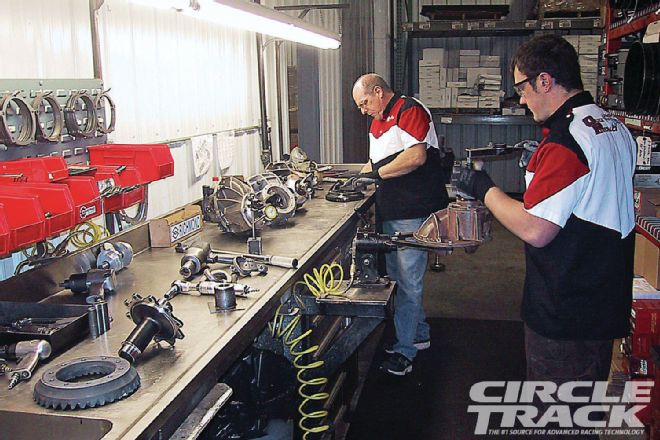 If the budget is tight, Quick Performance can build a rearend with a refurbished stock case, but you still have the confidence of knowing that the case has been thoroughly inspected and all the high-wear components like gears, bearings and seals are new.
If the budget is tight, Quick Performance can build a rearend with a refurbished stock case, but you still have the confidence of knowing that the case has been thoroughly inspected and all the high-wear components like gears, bearings and seals are new.
The mineral-based oils tend to work a lot better with the 9-inch for a couple of reasons. One of the bigger reasons is the hypoid angle the 9-inch gears are cut at. They are cut at a pretty extreme angle, which helps with strength. That’s one of the reasons the 9-inch gear is so strong because they typically have more teeth in contact at all times than other styles of rearends, but that also generates a lot of heat. The mineral-based oil does tend to impregnate the metal better and actually does a better job of pulling the heat out of the ring-and-pinion and helping it run cool.
Now, a lot of guys will argue that and say “Well, when I run synthetic my rearend doesn’t feel hot.” But that’s because the synthetic oil is not as good a job pulling the heat out of the ring-and-pinion metal and dissipating it through the rearend. It is actually acting as an insulator instead of helping dissipate the heat.
Just keep it simple and use the silicone, that usually works out best
For a circle track application we do recommend four quarts (a full gallon) of a non-synthetic, high-quality 80 to 90 weight gear oil. We also recommend that it be GL-5 rated. The reason that we recommend so much is because we don’t run inner tube seals in our rearends.
I do get asked quite a bit about the inner tube seals, and we don’t really recommend them. I have seen multiple occasions where the seals will wear a little bit and actually let oil sneak past it. Then the oil gets trapped out in the tube behind the seals and you run the risk of starving your ring-and-pinion of oil. When there is too little lubrication around the gears it winds up getting a hot, which ultimately leads to failure.
On the other hand, if you do not run the seals you allow the oil to run out into the tube, which helps it cool down. And by running a full gallon you have a sufficient amount to where you are not running dry at any point. It does also get some of that oil to the outer bearings, but I still recommend that you keep an eye on them and repack your bearings as necessary, but it doesn’t hurt them.
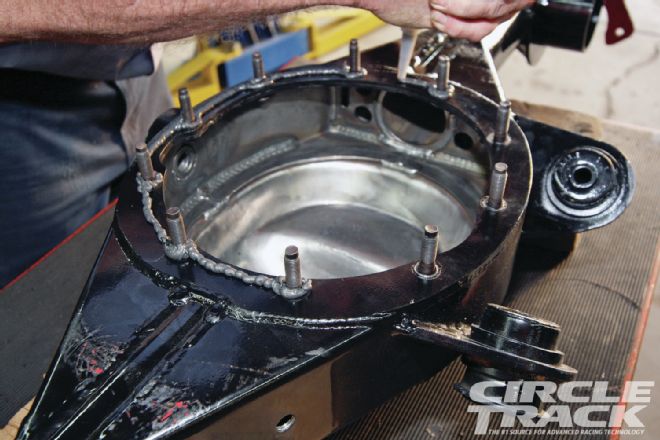 Often the simplest fixes are the best. Quick Performance recommends sealing the third member to the housing with good old RTV sealant. It seals just as well as a gasket and won’t throw off the alignment between the spool and the axles.
Often the simplest fixes are the best. Quick Performance recommends sealing the third member to the housing with good old RTV sealant. It seals just as well as a gasket and won’t throw off the alignment between the spool and the axles.
Do I need to break in a new rearend?
The short answer is yes. For a new ring-and-pinion set and bearings, those things definitely need to be properly broken in. I understand that a lot of guys want to just put a new rearend or center section in the car and take off and go, but that’s really detrimental to the life of the ring-and-pinion. There are a couple different ways we recommend to properly break in a ring-and-pinion. The guy could put the car up on stands and let it run in gear without putting a heavy load on it until the gears get up to temperature. Once it is at operating temperature, shut the car off and let it cool down naturally and then repeat that heat cycle four times. Or if you have access to a track or private roads or something that you could run some laps at half speed, that is acceptable too -- as long as they are not driving aggressively. And you need four heat cycles with this method as well. After that you should be good to go. Just make sure everything looks good and you don’t have any leaks. You don’t necessarily have to change your gear oil after the break in. Some guys do and some guys don’t; I don’t think that’s a major concern. But if you do look at the oil and there is a lot of shavings in it, you may have something else going on. Anytime you see metal in your oil, it’s probably a good idea to stop and take a good look around to see what might be causing that.
How often should the gear oil be changed?
That’s a good question. About every eight nights of racing or so should be reasonable. Whenever you do change your gear oil, that’s also a good time to make a quick check on your gears. The first check is with your nose. Mineral-based oil has a very distinct smell. We can actually tell pretty easily by just smelling a gearset if it is then ran with synthetic or mineral-based oil. And if the gear has seen too much heat the mineral-based oil will smell burnt too. If it does smell really burned, chances are you may need to pay some more attention to the rearend. You can have a ring-and-pinion that is not set up properly, you can have too much preload on your bearing, you can have a bearing that’s going bad. I always suggest you use all of your senses and don’t limit it to just the way it looks. Shine a light through the oil fill hole and take a look at your gears. Run the oil between your fingers and feel for metal. If you find anything that seems out of place, definitely do some more investigating to make sure that if there is an issue you find the root cause of it. Catching a potential problem early will almost always save you time and money because you can avoid having to fix bigger problems down the line.
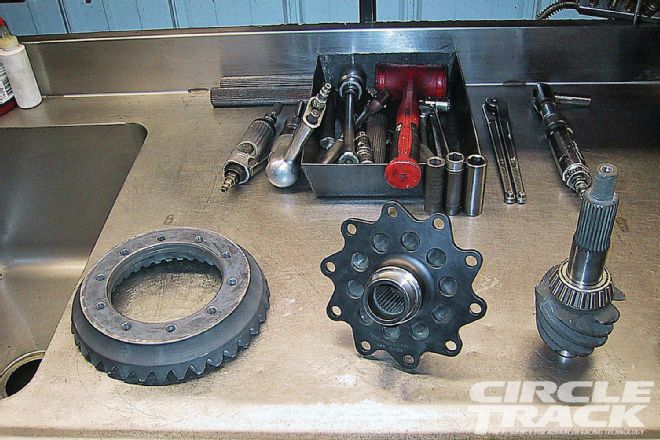 A full spool (shown here in the center) cuts a significant amount of weight because it replaces the cast-iron carrier and spider gears which can weigh 6 to 8 pounds.
A full spool (shown here in the center) cuts a significant amount of weight because it replaces the cast-iron carrier and spider gears which can weigh 6 to 8 pounds.
Any other maintenance tips?
The heavy-duty tapered bearings on the floating 9-inch rearends have a seal built into them that can be another fairly common issue. Guys are always in a hurry at the track. They are pulling their axles out, and when they go in just jamming things together. If that seal gets pinched or mangled, it obviously won’t seal up as good as it used to, and that can lead to issues. I try to tell people to slow down and take a minute when they are putting things back together and try to make sure that seal doesn’t get pinched.
If you notice the seal is gritty, the bearing makes a grinding sound or the wheel has more resistance when turning it by hand, that would be a good sign that your bearing may have sand or grit in it and needs attention. Repacking your wheel bearings should be a part of every race team’s regular maintenance routine, and depending on your conditions you may have to do it quite often.
You have to take care with your wheel studs. A lot of guys will take an impact gun and just spin those lug nuts home. And that’s not good. We recommend 75 foot-pounds of torque. If you go much past that spec, it will stretch the wheel studs, which will significantly weaken them. That could lead to other bigger issues such as a failure of the stud.
As far as sealing up the third member to the housing. We recommend using a high-quality, oil-resistant RTV silicone gasket maker. That will seal up and work a lot better than a gasket. There are a lot of really thick reusable gaskets on the market, but we really don’t like those because it actually shims the third member out away from the housing. That will throw the centerline of your spool off from the centerline of the axles, which will cause extra wear and tear on your splines and other parts. Just keep it simple and use the silicone, that usually works out best.